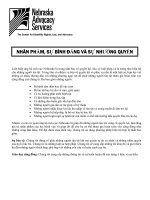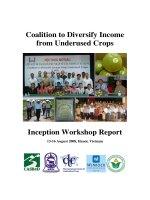UBI-GM-Presentation04.050112-culture pptx
Bạn đang xem bản rút gọn của tài liệu. Xem và tải ngay bản đầy đủ của tài liệu tại đây (3.11 MB, 29 trang )
Cultural Dynamics in Assessing Global Markets
Chapter 4
McGraw-Hill/Irwin © 2005 The McGraw-Hill Companies, Inc. All rights reserved.
PowerPoint presentation prepared by:
Alfred Lowey-Ball
Associate Professor of Marketing
UBI-United Business Institutes
Brussels, Belgium
MERRIL LYNCH in Japan
McGraw-Hill/Irwin © 2005 The McGraw-Hill Companies, Inc. All rights reserved.
•
Liberalization of Japan’s capital markets gives more freedon
of choice to private citizens
•
Freeing of capital from time deposits held by the postal
system
•
Opportunity for equities? Merrill rushed in.
•
No No stock owning risk-taking culture in Japan
9% households invested in stocks vs 50% in US
No boost from internet connectivity
•
Merrill now cutting back in Japan.
•
Similar hesitancy in Europe
Chapter Learning Objectives
1. The importance of culture to an international
marketer
1. The importance of culture to an international
marketer
2. The origins and elements of culture
2. The origins and elements of culture
3. The impact of cultural borrowing
3. The impact of cultural borrowing
4. The strategy of planned change and its
consequences
4. The strategy of planned change and its
consequences
Introduction
Culture is the “the human-made part of human environment—the
sum total of knowledge, beliefs, art, morals, laws, customs, and
any other capabilities and habits acquired by humans as members
of society”
Culture is the “the human-made part of human environment—the
sum total of knowledge, beliefs, art, morals, laws, customs, and
any other capabilities and habits acquired by humans as members
of society”
A successful businessman/marketer must be a
student of culture
A successful businessman/marketer must be a
student of culture
Culture is pervasive in all marketing activities—
in pricing, promotion, channels of distribution,
product, packaging, and styling
Culture is pervasive in all marketing activities—
in pricing, promotion, channels of distribution,
product, packaging, and styling
Critical importance of culture in international
business and marketing
Critical importance of culture in international
business and marketing
Culture’s Pervasive Impact
•
Culture influences every part of our lives
•
Cultural impact on birth rates in Taiwan, Japan, and Singapore
Year of the dragon (1976, 1988) good luck
Year of the Fire horse (1966, 60 year cycle) bad luck
•
Culture influences every part of our lives
•
Cultural impact on birth rates in Taiwan, Japan, and Singapore
Year of the dragon (1976, 1988) good luck
Year of the Fire horse (1966, 60 year cycle) bad luck
•
Birthrates have implications for sellers of diapers, toys,
schools, and colleges etc.
•
Birthrates have implications for sellers of diapers, toys,
schools, and colleges etc.
•
Consumption of different types of food influence is culture:
Chocolate by Swiss and Belgians, seafood by Japanese preference,
beef by British, wines by France and Italy
•
Even diseases are influenced by culture:
stomach cancer in Japan, and lung cancer in Spain
•
Consumption of different types of food influence is culture:
Chocolate by Swiss and Belgians, seafood by Japanese preference,
beef by British, wines by France and Italy
•
Even diseases are influenced by culture:
stomach cancer in Japan, and lung cancer in Spain
Birthrates in developed countries
Patterns of Consumptions in the West
Consequences of consumption
Definitions and Origins of Culture
Culture has been conceptualized as:
1. “Software of the mind” culture is a guide for humans on how
to think and behave; it is a problem-solving tool (Hofstede)
2. An invisible barrier… a completely different way of organizing
life, of thinking, and of conceiving the underlying assumptions
about the family and the state, the economic system, and even
Man himself” (Hall)
3. A “thicket” (U.S. Ambassador Hodgson)
Culture is the sum of the “values, rituals, symbols, beliefs, and thought processes
that are learned, shared by a group of people, and transmitted from generation to
generation”
Culture is the sum of the “values, rituals, symbols, beliefs, and thought processes
that are learned, shared by a group of people, and transmitted from generation to
generation”
Influence of culture on business behaviour
Origins of Culture: Geography
1. Geography, which includes climate, topography, flora, fauna,
and microbiology, influences our social institutions
1. Geography, which includes climate, topography, flora, fauna,
and microbiology, influences our social institutions
2. Two researchers
suggest that
geography
influences
everything from
history to present-
day cultural
values
2. Two researchers
suggest that
geography
influences
everything from
history to present-
day cultural
values
3. First, Jared
Diamond states
that historically
innovations
spread faster
east-to-west than
north-to-south
3. First, Jared
Diamond states
that historically
innovations
spread faster
east-to-west than
north-to-south
4. Second, Philip Parker reports strong correlations between the
latitude (climate) and the per capita GDP of countries
4. Second, Philip Parker reports strong correlations between the
latitude (climate) and the per capita GDP of countries
Origins of Culture: The Political Economy
1. For most of the 20th Century three approaches to
governance competed for world dominance: fascism,
communism, and democracy/free enterprise
1. For most of the 20th Century three approaches to
governance competed for world dominance: fascism,
communism, and democracy/free enterprise
4. Necessary to appreciate the influence of the political
economy on social institutions and cultural values and
ways of thinking
4. Necessary to appreciate the influence of the political
economy on social institutions and cultural values and
ways of thinking
2. Fascism fell in 1945; Communism crumbled in the
1990s in the USSR and Eastern Europe. Undergoing
change in China and Vietnam
3. Prevalence of democracy/free enterprise??
2. Fascism fell in 1945; Communism crumbled in the
1990s in the USSR and Eastern Europe. Undergoing
change in China and Vietnam
3. Prevalence of democracy/free enterprise??
Origins of Culture: Technology
1. Technological innovations also impact institutions and cultural
1. Technological innovations also impact institutions and cultural
2. Railroads, autobahnen, jet aircraft, air
conditioning, televisions, computers,
mobile telephones and now the
internet have all profoundly
influenced culture
2. Railroads, autobahnen, jet aircraft, air
conditioning, televisions, computers,
mobile telephones and now the
internet have all profoundly
influenced culture
3. The birth control pill and now the male potency pills have had
the most profound influence on (Werstern??) culture
3. The birth control pill and now the male potency pills have had
the most profound influence on (Werstern??) culture
Origins of Culture: Social Institutions
•
Social institutions including family, religion, school, the media,
government, and corporations are manifestations of culture
•
Social institutions including family, religion, school, the media,
government, and corporations are manifestations of culture
•
The family, social classes, group behavior,
age groups, and how societies define
decency and civility are interpreted
differently within every culture
(1) Family behavior varies across the world,
e.g., extended families living together to Dad
washing dishes
(2) Religious value systems quite strong: they
differ across the world,
e.g., Muslims and Jews not allowed to eat
pork to Hindus not allowed to consume beef
Origins of Culture: Social Institutions
(3) School and education, and literacy
rates affect culture and economic
growth
(4) Media (magazines, TV, the Internet)
influences culture and behavior
(5) Government policies influence the
thinking and behaviors citizens of adult
citizens, e.g., the French & Belgian
government offer “birth bonuses” as an
incentive to increase family size
(6) Corporations influence culture via the
products they market, e.g., MTV
Elements of Culture
International marketers must design products, distribution systems,
and promotional programs with due consideration to culture, which
is defined as including five elements:
International marketers must design products, distribution systems,
and promotional programs with due consideration to culture, which
is defined as including five elements:
1. Cultural values
2. Rituals
3. Symbols
4. Beliefs
5. Routine thought
processes
Elements of Culture: Cultural Values
•
Differences in cultural values, which is found to exist among
countries, affects consumer behavior
•
Hofstede, who studied over 90,000 people in 66 countries,
found that the cultures differed along four primary dimensions:
•
Differences in cultural values, which is found to exist among
countries, affects consumer behavior
•
Hofstede, who studied over 90,000 people in 66 countries,
found that the cultures differed along four primary dimensions:
1. Individualism/Collective Index (IDV), which focuses on self-
orientation
2. Power Distance Index (PDI), which focuses on authority
orientation
3. Uncertainty Avoidance Index (UAI), which focuses on risk
orientation; and
4. Masculinity/Femininity Index (MAS), which focuses on
assertiveness and achievement
Individualism/Collectivism Index
•
Individualism/Collectivism Index:
•
Individualism/Collectivism Index:
1. The Individualism/Collective Index refers to the preference
for behavior that promotes one’s self-interest
2. High IDV cultures reflect an “I” mentality and tend to
reward and accept individual initiative
3. Low IDV cultures reflect a “we” mentality and generally
subjugate the individual to the group
4. Collectivism pertains to societies in which people from birth
onward are integrated into strong, cohesive groups, which
protect them in exchange for unquestioning loyalty
Power Distance Index
•
Power Distance Index:
•
Power Distance Index:
1. The Power Distance Index measures power inequality
between superiors and subordinates within a social system
2. Cultures with high PDI scores tend to be hierarchical and
value power and social status
3. High PDI cultures the those who hold power are entitled to
privileges
4. Cultures with low PDI scores value equality and reflect
egalitarian views
Uncertainty Avoidance Index
•
Uncertainty Avoidance Index:
•
Uncertainty Avoidance Index:
1. The Uncertainty Avoidance Index measures the tolerance of
uncertainty and ambiguity among members of a society
2. High UAI cultures are highly intolerant of ambiguity,
experience anxiety and stress, accord a high level of
authority to rules as a means of avoiding risk
3. Low UAI cultures are associated with a low level of anxiety
and stress, a tolerance of deviance and dissent, and a
willingness to take risks
3 Dimensions influencing business behavior
Elements of Culture: Rituals, and Symbols
•
Rituals are patterns of behavior and interaction that are learned
and repeated vary from country to country, e.g., extended lunch
hours in Spain and Greece
•
Rituals are patterns of behavior and interaction that are learned
and repeated vary from country to country, e.g., extended lunch
hours in Spain and Greece
•
French and German attempts to
preserve the purity of their
languages from English
•
French and German attempts to
preserve the purity of their
languages from English
•
Language as Symbols: the
“languages” of time, space, things,
friendships, and agreements
•
Language as Symbols: the
“languages” of time, space, things,
friendships, and agreements
Elements of Culture: Rituals, and Symbols
•
In Belgium and Canada, language has been the focus of
political disputes including secession
•
In Belgium and Canada, language has been the focus of
political disputes including secession
•
Aesthetics as Symbols: the arts,
folklore, music, drama, and dance
of a culture influences marketing
•
Aesthetics as Symbols: the arts,
folklore, music, drama, and dance
of a culture influences marketing
•
Differences in language vocabulary
varies widely
•
Differences in language vocabulary
varies widely
Metaphors exemplifying cultures
Elements of Culture:
Beliefs and Thought Processes
Beliefs, which stem from religious training, vary from culture to
culture
Beliefs, which stem from religious training, vary from culture to
culture
In summary, marketers must consider larger cultural consequences
of marketing actions
In summary, marketers must consider larger cultural consequences
of marketing actions
Thought processes also vary across cultures
Thought processes also vary across cultures
Examples:
Examples:
•
The western aversion to the number 13 or
refusing to walk under a ladder
•
Japanese concern about Year of the Fire Horse
•
The Chinese practice of Feng Shui in designing
buildings
Examples:
Examples:
“Asian and Western” thinking
“Asian and Western” thinking









